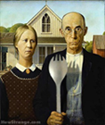|
I'm no expert but cutting stuff also removes metal, so you'll have two pieces a fair bit thinner than 1/8". Your best bet is going to be ordering the right stuff online (NJ Steel Barron is where I got mine). I need to harden and temper a round punch before class, but I don't remember exactly what he told me to do. I think it was like: 1. Heat in forge, tip in first, until the handle turns dark blue (or maybe it was to non-magnetic) 2. Quench the bottom half in oil (the side with the tip, not the handle) 3. Put in oven at broil 4. ??? don't remember the rest Anyone got instructions on how to best do this?
|
|
|
|

|
| # ? May 25, 2024 09:36 |
|
Our metalworking teacher got his hands on a good amount of titanium, and we're going to go watch them forge it tonight. It will be our first demo of team striking, and he's made it out to be a huge bitch to work with, so it ought to be interesting!
|
|
|
|
Ambrose - that pate knife is hilariously awesome. I've been making a lot of mini's lately, and have really been having fun with them. Absolutely love it. As far as getting the 1/4" cut thin, I'm not even sure it's possible, and even if it is, I'm going to bet that it'd cost way more than just ordering some 1/8" x whatever from Aldo (the New Jersey Steel Baron). Really, get some 1084 from Aldo. It's loving great stuff. hayden - not sure what steel you are using but, generally: 1) heat in forge to nonmagnetic 2) quench in oil, tip first (possibly just the tip half, depending on the steel structure types you want in the final piece, for a punch I guess that's right, just the tip half) 3) put in oven to temper back the hardness (probably on highest temp for a punch) 4) possibly repeat tempering (I generally do 2 or 3 1 hour tempers) edit: SYFY - take some pics and post them - I've never seen Ti forging. Sounds awesome.
|
|
|
|
artificialj posted:4) possibly repeat tempering (I generally do 2 or 3 1 hour tempers) Could you expand on this? What are you doing exactly, and why? Re: Tempering. If you are using ordinary carbon steel, and you temper it in the oven at 500 degrees, you will get a brown-yellow patina and will have a very hard - but not quite glass-hard - item at the end. This is fine for a file but possibly not tough enough for a knife blade - especially a relatively thin one. For a knife or (especially) anything I'm going to strike, the spine/back/strikepoint needs to be tempered hotter. You can do this by holding the part of the metal to be tempered in a flame (such as from a torch, or the exhaust port on your gas forge) or positioning it in your coal/charcoal forge-fire so that just the part you want to heat is being heated. You need it to heat fairly rapidly so that the heat doesn't bleed into the part you want to remain hard. The instant it hits the right color (say, a light purple), quench in oil to stop the heat from spreading. This sort of differential-tempering is kind of an art, but it's the best way to combine a tougher/softer area of the piece with a harder/more brittle area. If you screw it up, you can always "reset" by heating to nonmagnetic and starting over. e. here is a temper color chart which is very useful because you can find out what hardness a given temperature translates to, for your particular alloy. Leperflesh fucked around with this message at 02:32 on Oct 13, 2011 |
|
|
|
Thanks for the heat treating help guys. edit: I asked this on a blacksmtihing forum too and it only took to the third reply until some pretentious gently caress was like "If you were my student you would not be invited back". Jesus christ, these people. hayden. fucked around with this message at 11:59 on Oct 13, 2011 |
|
|
|
Leperflesh posted:Could you expand on this? What are you doing exactly, and why? First, let me just preface this by saying that this only really matters for eutectoid and hypereutectoid steels, and also for anything with complicated alloying elements. And sorry, I am going to touch on some metallurgy overview stuff (don't think I'm trying to instruct, just helps my train of thought to have it written out). The goal(s) of tempering (for knives, anyway) is to release some carbon from the highly stressed alpha martensite (a supersaturated body centered cubic structure). This does a couple of things, most importantly, the stress relief of getting some extra carbon out of solution makes a knife more tough, by sacrificing hardness. Also, the precipitation of carbon from the martensite can be useful in carbide formation, particularly when dealing with heavily alloyed steels. Tempering is not only a temperature, but a time based process. So why the long soak time at temp as opposed to a quick temper? At lower temperatures, you can control the formation of pearlite and cementite, and instead just stress relieve the martensite. This means that you have less hardness loss for a given toughness gain; that is, lets say you want the toughness that you might gain by torch tempering at 450F. With additional time at temperature, you might be able to get that at 425F, and not be losing the additional hardness points that a hotter temp gives you. (those are made up numbers) Why the multiple temper cycles? Any real world quench (that is, non ideal) is going to lead to retained austenite in your quenched blade. During the first temper cycle, some of this retained austenite will flip and turn into martensite, but will still be highly stressed. By tempering in a couple cycles you convert the retained austenite into martensite, then stress relieve it. edit: Editing to say that I do, also, torch temper, after oven tempering. I use the oven cycles for control at the edge only, and then differentially temper the rest of the blade. artificialj fucked around with this message at 05:16 on Oct 13, 2011 |
|
|
|
hayden. posted:Thanks for the heat treating help guys. Ugh, I know, they're loving dicks. I wish I understood why. I mean, people are there, asking intelligent questions and hoping to, you know, learn something. Knowledge is for sharing and passing along, we're not dark age alchemists hoarding whatever bullshit wisdom we've been able to glean from a poor understanding of science. We're modern, scientific people who's entire society is built on sharing what we know. Dinosaurs. Ambrose: if I had that material, I would cut it lengthwise on the bandsaw (or with a chisel if you don't have one) but on the flat. Then take the skinny blanks and draw the blade out from that. It's what, 1 1/4 x 1/4? I'm trying to judge based on the quarter, so hopefully that's right. That would give you 2 blanks slightly smaller than 9/16 x 1/4 which is just about right to pull into a blade face. (I think, anyway.)
|
|
|
|
Slung Blade posted:I think you'd be better off using the lava to generate steam to run a generator and have an induction forge hooked up to that. Found this a little while ago, thought I would share it so you can all see they're not just little toys. https://www.youtube.com/watch?v=WUnAG3UEFAY
|
|
|
|
Slung Blade posted:Ambrose: if I had that material, I would cut it lengthwise on the bandsaw (or with a chisel if you don't have one) but on the flat. Then take the skinny blanks and draw the blade out from that. It's what, 1 1/4 x 1/4? I'm trying to judge based on the quarter, so hopefully that's right. That would give you 2 blanks slightly smaller than 9/16 x 1/4 which is just about right to pull into a blade face. (I think, anyway.) That's... that makes sense. I'd still have to move metal mass but a lot less so it's not so tedious. And it's doable. Thank u
|
|
|
|
Hayden, Rich can be really nice or a jackass depending on how he feels that particular day. He was incredibly rude to you but there is a message there. You learn how to do that basic heat treat through repetition and until you have done it enough that it is second nature, you really ought to take notes on everything and/or step up and ask your teacher to repeat his instructions if you forgot. I am in the process of making a binder full of different methods and techniques to help me think outside the box on a tougher project. You can't remember everything, especially when you are exhausted from forging all day.
|
|
|
|
The class is a very casual setting, there's no grading, no expectations, and everyone is just there to learn and have fun. It's not SERIOUS BUSINESS like everyone at the other site is making it out to be. Also do you own that site or is your username just coincidence? In other news, I got the HTC-100 applied to my forge and it helped a little, but not much. I think I need to close the open end to really make it work well.
|
|
|
|
Well, this almost makes me wish I remembered more of trigonometry... http://www.youtube.com/watch?v=gTI8l9Is0G0 Why does watching that give me such a? I seem to have lost the "favorite" on my thread list, where'd the thread that the guy was restoring an old lathe? He had the hardest time getting the paint off it. Last I remember it was over the hump and on its way back together with a new motor/controller... vvvvv: That's the most I've learned about woodworking since New Yankee Workshop in the 90s. I clicked the link for "viking toolchest" episode too. Sponge! fucked around with this message at 19:30 on Oct 14, 2011 |
|
|
|
Not blacksmithing but related to that youtube, I saw this episode of the Woodright's Shop where they had an old-rear end thing for boring square holes. How far we've come! http://www.pbs.org/woodwrightsshop/video/2800/2807.html
|
|
|
|
hayden. posted:In other news, I got the HTC-100 applied to my forge and it helped a little, but not much. I think I need to close the open end to really make it work well. IANYAGFO (I Am Not Yet A Gas Forge Owner), but that seems to be the consensus among people who've built forges that underperform (from what I've read browsing blacksmithing forums, anyways)- that although HTC-100 and a round, venturi-conducive forge chamber and a good solid Satanite coating over your Kaowool and etc etc are all important and helpful, they're all for nought when most of the heat is spilling out the front and back ports. When I get around to doing mine, I'll do it right- I'll go with the rigid-insulation-as-sliding-door + angle-iron-as-brackets setup at both ends right from the beginning. I haven't ordered my Kaowool yet but I'll get a sheet of rigid board at the same time.
|
|
|
|
I tried blocking off the entire front of my forge today leaving only about three square inches actually open in the rear. It got barely hot at all (mild steel only got to red hot after 10 min) and the propane was combusting outside the entrance. I opened up the front a bit to let in more air and it didn't help much. I took the front off completely and it was much better but still not great (steel getting to a dark yellow under the flame). The outside of the forge is hot to the touch, but not especially so (too hot to touch, not hot enough to melt plastic). So I don't think I'm really losing too much heat. Not sure what the deal is.
|
|
|
|
What are you using for a burner again? The bernzomatic torch with a 20 lb. tank?
|
|
|
|
Sponge! posted:vvvvv: That's the most I've learned about woodworking since New Yankee Workshop in the 90s. I clicked the link for "viking toolchest" episode too.  at the end of that clip, where he holds the thing up like the wrasslin' championship belt and challenges Norm.) at the end of that clip, where he holds the thing up like the wrasslin' championship belt and challenges Norm.)I seem to remember seeing another apparatus for boring square holes (through holes, no less) that is basically a square chisel around an auger bit. Is that actually a thing that exists? Because if so, I've already thought of a way to improve it -- put smaller drills in the corners to make the chiseling part easier. There would, of course, be some ridiculous planetary gearset to drive all five bits at once, but that's the easy part (the hard part is mounting said transmission). Edit: I love the trip hammer made of a sledgehammer tied to a rope with a treadle in the Viking episode. Chillbro Baggins fucked around with this message at 05:43 on Oct 15, 2011 |
|
|
|
Delivery McGee posted:Edit: I love the trip hammer made of a sledgehammer tied to a rope with a treadle in the Viking episode. I was thinking of doing this exact thing- affix the base of the handle to a nice sturdy hinge bolted to the floor, so it won't torque or drift much, and attach an old couch spring or something that's juuuuust a little too weak to the handle near the top at one end, and a joist/rafter at the other.
|
|
|
|
artificialj posted:What are you using for a burner again? The bernzomatic torch with a 20 lb. tank? Yes, it's the jumbo size one and has a flame close to an inch wide. I've tried positioning it a few different ways and it seems to make little difference. Maybe if I closed up the large open side again and hooked up some plumbing to force air in with the propane? The problem seems to be either not enough air or not enough insulation on the front entrance.
|
|
|
|
hayden. posted:Yes, it's the jumbo size one and has a flame close to an inch wide. I've tried positioning it a few different ways and it seems to make little difference. Can you post a picture of your torch head? Benzomatic makes lots of torch heads; but only some of them are 'self-aerating', in that the torch collects air all on it's own, and forces air/gas flame out the head. Since you mentioned that if you seal it up too much you start seeing the flame form in the remaining vent I think that may be your issue. You can likely build a aerating chamber for the flame inlet if you don't have the right torch head.
|
|
|
|
It does appear to have a little air inlet thing.
|
|
|
|
Delivery McGee posted:I remember watching Roy Underhill when Norm Abram was just Bob Vila's sidekick. Both their shows are basically the same thing, but Norm uses for tools and Roy kicks it old-school. ( It certainly exists. http://en.wikipedia.org/wiki/Mortiser http://mathworld.wolfram.com/ReuleauxTriangle.html Ever notice how the two-faced drill bits we use in metal tends to leave a bit of a triangular shaped hole? (or at least when you start the hole anyway) The three sided variety do the same thing, except they leave a 4 sided hole. 4 sided = pentagonal and so on. Honestly I'm not sure four additional drill bits would add much to it, the amount of material left by the 3 faced bit is pretty minimal. It would be cool as hell to try and see if it would work though.
|
|
|
|
Slung Blade posted:Honestly I'm not sure four additional drill bits would add much to it, the amount of material left by the 3 faced bit is pretty minimal.
|
|
|
|
Sponge! posted:Well, this almost makes me wish I remembered more of trigonometry...
|
|
|
|
I saw the drill bit that makes a square hole quite a while ago on the british show QI and these youtube videos cropped up on practical machinist. They're pretty expensive and theres a fairly limited application for them. If youre buying just the bit you'll need a special holder that describes the rounded square required to make it drill a square hole. It's center line has to move around to make the square.
|
|
|
|
So how far into the forge lining are you putting that torch head? It needs to be at least far enough outside of the forge to get air from those little air holes... How big is the inside chamber of your forge, btw? Like, diameter and length?
|
|
|
|
Finally got the titanium out this week. The videos are loud, fair warning: https://www.youtube.com/watch?v=o5O9NZXo08Q https://www.youtube.com/watch?v=piEeeIiV_B0 https://www.youtube.com/watch?v=jXXWwaeKeK4 https://www.youtube.com/watch?v=PchR5xAB-Ok https://www.youtube.com/watch?v=Xu_OOqPr0xk https://www.youtube.com/watch?v=n_EGl8RdZAo A coal fire going outside  Yellow Ti02 sloughing off everywhere  The yellow tip of a bar that's getting drawn out  Two sets of drawn out titanium for tongs 
|
|
|
|
My local Hackspace has a small anvil (seriously like 10kg) but is sadly lacking a forge. The other day I tried heating up a big mild steel bar in the kiln and bashing that just to get a feel for what this is like. Turns out its really fun. Obviously there were issues with this (massive oxidisation) so it is not really feasible. But it got me thinking maybe I could try making something out of copper, as it can be worked cold although it does need quenching to retain malleability. Does copper have any problems with being heated in a kiln? Would I get too much oxidisation? I'm thinking of making a copper frying pan. I think I am going to sign up to a blacksmithing course in Jan as this was so much fun. Shame I live in an flat and have no garage 
|
|
|
|
Antinumeric posted:My local Hackspace has a small anvil (seriously like 10kg) but is sadly lacking a forge. The other day I tried heating up a big mild steel bar in the kiln and bashing that just to get a feel for what this is like. The problem with copper is that it's expensive as gently caress. Also really god drat soft. This is coming from a machinist though, so take it with a grain of salt.
|
|
|
|
The tiny knife was adorable :3 I made a thread for jewelry, so I'll stop posting girly little things in your very manly thread now.
|
|
|
|
Antinumeric posted:My local Hackspace has a small anvil (seriously like 10kg) but is sadly lacking a forge. The other day I tried heating up a big mild steel bar in the kiln and bashing that just to get a feel for what this is like. I think a bigger problem would be the copper melting. Don't they use copper based pigments for glazing colours in kiln-fired pottery? According to a scientific survey of the internet, copper melts at 1083C, your typical gas forge will be a lot hotter than that. This doesn't mean you can't do it, you just have to be REALLY vigilant in not letting your workpiece get too hot. If you use the kiln or a forge, just keep your eye on it. No one wants to clean melted copper out of firebrick. You could make a little sheet steel box to put your workpiece in while in the kiln, that would reduce the damage if it did melt, and would reduce any losses to oxidation. Actually I have no idea if copper will oxidize in heat like that or not.
|
|
|
|
A couple blacksmithing books I have have guides on forging brass/copper and aluminum, and although there's an entirely different set of weird internal criteria you have to use (like, aluminum is optimally hot-forgeable when a pine twig touched to it immediately bursts into flame), but it's possible. Just don't wait for it to start glowing like iron to work it.
|
|
|
|
Yeah the biggest problem with aluminium is that it doesn't radiate light when its hot like iron does. So it can go from solid->liquid with almost no warning before it gets too hot. Iron will at least start sparking like crazy too, aluminium is practically inert up until it ends up as a puddle on your boot. Doable, but a major pain in the rear end.
|
|
|
|
Antinumeric posted:Turns out its really fun. Obviously there were issues with this (massive oxidisation) so it is not really feasible. But it got me thinking maybe I could try making something out of copper, as it can be worked cold although it does need quenching to retain malleability. Does copper have any problems with being heated in a kiln? Would I get too much oxidisation? I'm thinking of making a copper frying pan. So you're not quenching, you're annealing. Basically restoring the grain boundaries from the cold working you do to it. I've seen copper worked from a coal forge, which is definitely hot enough to melt it. You should keep it away from the hottest parts of the fire and you can tell if it's annealed right by the sound it makes when you "quench" it in water. It makes a kind of quick higher pitched sizzle from what I remember. I've never done it myself though. If you wanted to make a copper frying pan, it would be better to use a propane or other fuel based torch. That way you can control the heating easier.
|
|
|
|
Wow thank you for all of the help guys. I found a piece of scrap copper pipe, cut a slit in it and flattened it and used it to practise on. The kiln only goes up to 800C so I think that is good. Lessons learnt: 1. Oxidises like crazy in the kiln, the whole surface goes a silver colour that turns black and flakes right off when cooled. It only seems to be the outer layer though. 2. Copper is a poo poo ton more heat conductive than Iron, with a similar size piece of iron I could hold one end barehanded while the other was glowing red. Burnt my fingers absentmindedly doing the same with copper. Don' be an idiot wear PPE next time, even with the iron. 3. Cold working is fun! You do not have the race against time you do with iron. I need to practise a bit more, going to try work hardening a flat surface next (I assume that is what all of the small divots and bumps I see in worked copper are). And how to turn a sheet into a pan without a crease forming. It's very annoying because I found a Redsmiths manual a few years back but I was a poor student who couldn't afford the £10 
|
|
|
|
Antinumeric posted:Wow thank you for all of the help guys. I found a piece of scrap copper pipe, cut a slit in it and flattened it and used it to practise on. The kiln only goes up to 800C so I think that is good. Yeah most copper is cold worked with lots of annealing with a rosebud tip on the O/A torch. Its how the cladding for the Statue of Liberty was made. Oh and get some shot-pillows if you're gonna go for bowls or codpieces or hats.
|
|
|
|
Every so often I'm reminded that the Statue of Liberty was entirely repousséd and I feel a little smaller.
|
|
|
|
Jesus christ that's incredible. I'm gonna look into getting a torch and some kit, I might just be able to pull off coppersmithing at home.
|
|
|
|
Ambrose Burnside posted:Every so often I'm reminded that the Statue of Liberty was entirely repousséd and I feel a little smaller. I'm gonna have to steal this for the PYF fact that makes your brain explode thread, because god drat my brain exploded.
|
|
|
|

|
| # ? May 25, 2024 09:36 |
|
I probably asked here a while back, but can anyone recommend any Lathe and Milling books?
|
|
|













 Bad Angus! Bad!
Bad Angus! Bad!



